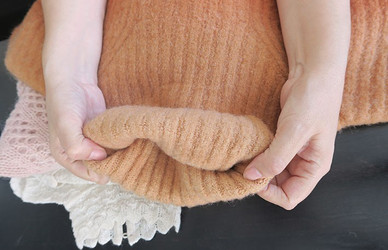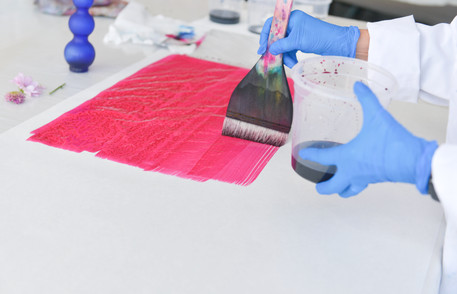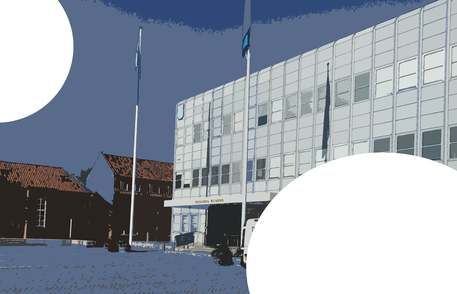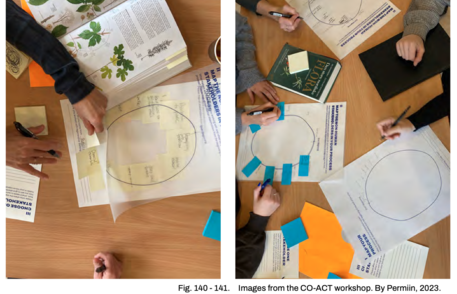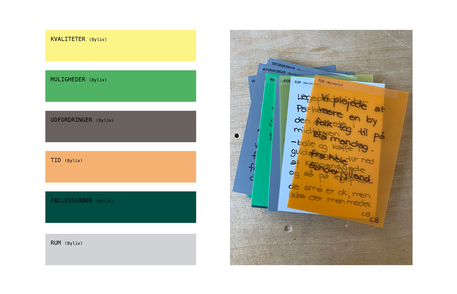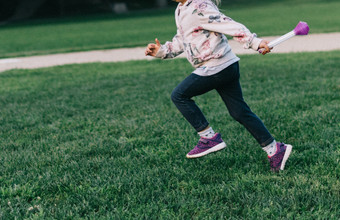Facts
Description
This PhD thesis – Design of Knitted Jumpers for Longevity: Knitted Prototypes as a Tool for User Dialogue in the Design Process – examines ways in which the textile designer can contribute to sustainable solutions that can help extend the life of knitted jumpers. The project addresses challenges in the textile and clothing industry related to sustainable change.
My research is focussed on the role of the textile designer in the development of the industry in view of the paradigm shift that the industry faces. The thesis is the product of an experimental and practice-based PhD project. The theme of the project is industrial manufacturing of flat-bed knitting and textile design approaches aimed at extending the life of knitted jumpers. At the same time, the use phase is examined, which is perceived as central in the transition to more sustainable behaviour within the industry (Fletcher, 2012; Niinimäki, 2011; Laitala, Boks, & Klepp, 2015).
Design til tiden podcast
Purpose
The overall objective of the project is to generate knowledge that can contribute to sustainable development through design practice, and the intention is to support the textile designer's role in this development. Although the need for clothing to last longer is widely recognized as a sustainable strategy, it can be difficult to implement. Therefore, elements of theories and design strategies are tested and challenged in practice, in order to develop knowledge and inspire textile designers and companies.
Methods
In the thesis I apply theories and theoretical framworks to explain how the designer, through strategic approaches, can work with business concepts and design development aimed at sustainable potentials. To further gain an understanding of more concrete approaches, the concept of durability is examined and explained based on the technical, emotional and aesthetic aspects of clothing. This illustrates the close relationship between the technical, emotional and aesthetic aspects and the textile designer's professional competencies. The beginning of the thesis highlights the textile designer's ability to develop textile constructions and work with key components such as colours, ornamentation and surface treatment. This ability provides insight into and experience with the technical and aesthetic properties of clothing that relate to the aforementioned aspects of durability. Working purposefully on emotional aspects is more difficult for the designer since people have individual experiences and perceptions. Hence an unambiguous answer can never be provided. Nonetheless, research studies show that joy and satisfaction with the use of clothing can potentially lead to longer life (Niinimäki, 2011, p. 210). In addition, I explain that it is not only relevant to consider the life of the clothing, but that the use frequency of the clothing can have a significant impact on its overall environmental footprint (Laitala et al., 2018, p. 11). Based on this knowledge, I consider the use phase as a valuable insight that the designer can incorporate into her work aimed at a more sustainable future.
The development of digital knitting technology opens up for new manufacturing methods and the opportunity to use several design strategies aimed at sustainability. The thesis explains how manufacturing methods such as fullyfashion and production on-demand may result in zero-waste production in which only essential resources are used. In addition, the technological development offers the potential to combine production on-demand with mass-customisation. My starting point is the potential of design and production of knitted jumpers, and I use these manufacturing methods in my analysis of a user-involved design approach. In that connection, I develop the design concept – a concept for the design of knitted jumpers that serves as a framework for examining an open design process. I use my experience as a designer to incorporate knowledge from the use phase into the development of the design framework concept, and the users are offered a number of aesthetic choices prior to the production of their knitted jumpers. Furthermore, the jumper can be adapted to the individual user's body measurements. Research shows that problems related to size and fit are the second most significant reason why clothes are not used and are being discarded (Laitala et al., 2015, p. 98). Standard size systems do not take into account various bodily structures, such as narrow shoulders and wide hips, short and long body height or bust size relative to the rest of the body's proportions.
The research process is built around the design concept alternating between design experiments with users and experiments in the knitting workshop proceeding through the following three phases: (1) use of knitwear, (2) user involvement in the design process, and (3) use of a personal knitted jumper.
(Phase 1) In the first phase of the project, I seek insight into three users’ needs and preferences in terms of knitwear. The purpose is to apply the collected knowledge in my own process of developing the design concept based on mass customisation. The design concept is being developed between phase 1 and phase 2 based on knowledge and insights from the design experiment phase 1.
(Phase 2) The starting point of phase 2 is the options for mass-customisation of the design concept, and it involves the users in the design process regarding the choice of a personal knitted jumper. Design experiment phase 2 consists of a series of workshops in which 46 users are invited to select their favourite knitted jumper based on the design framework of the concept. I produce the knitted jumpers for selected users between phase 2 and phase 3.
(Phase 3) In phase 3 of the project three users are given a jumper, and their experience wearing an individually made knitted jumper is the subject of my analysis. In design experiment phase 3 these users and their use of the knitted jumper are followed for an entire year.
Through these three phases I investigate a user-involved design approach to the development of knitted jumpers. The objective is to study how this approach affects my own design process and how it is received by the users.
Results
The design experiment phase 1 provided insights into how the users' aesthetic experience with knitted jumpers influences their preferences and furthermore may affect the frequency of use of their knitted jumpers. The user narratives showed that the users' experience with knitted jumpers has made them aware of which colours, jumper styles and fits they prefer and which they believe suit them best. The experiment also showed that these are the types of knitted jumpers that are used most often. The acquired insights highlight a potential for developing variations of jumper style that suit different aesthetic preferences and body shapes. I identified three categories where the users' preferences affect the use of the particular knitted jumpers: visual expression, jumper style, proportions and fit, as well as the tactility of the material. These categories are used in the development of the design concept as an inspiration for preparing design parameters for customisation.
In a concept based on mass customisation, the collection system is designed as a system from which the user can make design choices. Such an approach challenges the designer in new ways compared to a traditional collection of knitted jumpers, where the user is not involved in the design process and the options therefore are limited (Fletcher & Grose, 2012, p. 162). I elaborate on this challenge through examples from my own process and also include examples from the knitwear company Unmade, which serves as a design case in the dissertation. Unmade also works with a user-involved design approach through mass customisation using newly developed digital knitting technology. My analysis of Unmade's collection system, as well as my contact with Unmade throughout the project, has provided insight into how this systemic approach challenges the designer to venture into new work processes and new ways of thinking, for example when the designer takes on the role of a stylist who facilitates the users’ engagement in the design process.
The second and third phases of the project focus on how this user-involved design approach is received by the users. Design experiment phase 2 indicated that the users were interested in taking part in the design process and were capable of making design decisions related to the design of their personal knitted jumper. The users took advantage of the design concept parameters to make personal choices. Some users preferred simple and neutral expressions, while others wanted to disrupt a simple or neutral expression with contrasting details. My analysis of the experiment demonstrated that the knitted prototypes of the design concept also had a significant impact on the users' design choices. The users treated the knitted prototypes as narratives of what their choices would look like and how they would fit in with the rest of their wardrobe. Therefore, the knitted prototypes proved to be an important tool for expanding the users' imagination when they were included in the design process.
Design experiment phase 3 provides insight into how users use their personalised knitted jumpers. The experiment shows that the users integrate the knitted jumpers into the rest of their wardrobe. They have a feeling that their personal knitted jumper suits them well – both in terms of visual expression and fit. The users' stories indicate that aesthetic aspects such as these affect their joy of wearing the garment. In addition, they describe that the durability (technical aspects) of the garment is important, e.g. that the textile will not pill. As far as the emotional aspects are concerned, the users received compliments for their knitted jumpers, which, they declare, help them confirm their personal choices underscoring the feeling that their knitted jumper is something special to them.
It is hard to know how this feeling will affect the users' relationship to the knitted jumper in the long run. What I can conclude, based on this experiment, is that the users still actively use the knitted jumper after one year, and that they express joy and satisfaction with using it. In addition, the experiment exemplifies that users further personalise their knitted jumper through use and styling. These examples illustrate a potential for designers to focus to a greater extent on clothing that allows the user to take ownership of the expression of the clothing – also during the use phase.
Conclusion
My studies show that there is a connection between the user's personal preferences, her aesthetic experience of her own knitted jumper and the use frequency of the jumper. Thus it could be advantageous for textile designers and companies to focus their attention on material qualities and the aesthetic experience. The dissertation also demonstrates a design potential for a user-involved design process and provides practical examples of how textile designers can utilise and further develop their core competencies (knowledge of technology, aesthetic means and emotional value) in such a process. Furthermore I would particularly like to emphasise the use of knitted prototypes as an outcome of the project. Throughout the three phases of the project I have used different types of knitted prototypes in order to create a dialogue with the users. My use of the prototypes exemplifies how the designer can use them to gain insight into the use phase. In addition, my studies reveal that the knitted prototypes reinforce the users’ participation in the design process.
The project's development of knowledge is generated through practice. This is also the main contribution of the thesis, which thus adds insight to the discussion about the role of the textile designer in the development that the industry is facing in regard to research as well as in practice. I would like my practice-based approach in this project to be an inspiration to the textile designer and to companies that strive to work with active use and longevity. In terms of research, the project contributes specifically to the field of sustainable textile and clothing design, since I apply my design expertise to challenge theoretical perspectives, thereby generating new knowledge. I thus develop knowledge through practice, and the project contributes to the ongoing discourse about the use phase as a path to sustainable change in the field of textiles and clothing.
